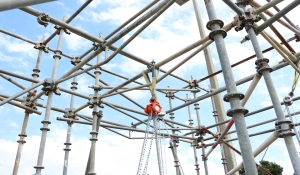
Introduction
American Clean Power noted in their 2020 Q4 report that the year was “a banner year for the wind industry” in the United States with 54 new projects commissioned and more wind installed in Q4 than in any other year combined, save for 2012.
The next few years are set to outstrip those figures, with government initiatives taking root and offshore farms entering first phases of development both on the Atlantic and Pacific coast.
With this enormous surge in wind farm construction comes the inevitable rise in demand for wind technicians and crane and rigging crews.
The U.S. Bureau of Labor Statistics predict an astonishing 68% growth in the number of wind turbine technician jobs over the next 10 years.
Given the unavoidable dangers associated with constructing turbines towering hundreds of feet in the air, it is paramount that highly trained, highly qualified crews direct the lifts.
While the crane operator is an obvious focal point, just as important is the team rigging the load.
Failure to rig properly could lead to structural failure, dropped loads, millions of dollars in damage, injured personnel, perhaps even lives lost.
To that end, this article will highlight the importance of rigging certification and the options therein.
Why is Rigging Certification Important?
Trained, certified and qualified riggers are essential for safe picks on wind farms.
Their expertise will mitigate risks, be of immeasurable benefit to the crane operator(s), and ensure well-planned, well-executed lifts at every stage.
Regarding industry standards and regulations, the language is currently vague. The ANSI/ASME B30 series simply state the 8 responsibilities of a rigger [B30.5-3.1.3.4(b)].
Similarly, OSHA is relatively silent, noting only that “[t]he materials must be rigged by a qualified rigger” [1926.1425(c)(3)]
The definition of a qualified rigger, provided in OSHA 1926.1401, is simply “a rigger who meets the criteria for a qualified person” which is, in turn, defined as:
“a person who, by possession of a recognized degree, certificate, or professional standing, or who by extensive knowledge, training and experience, successfully demonstrated the ability to solve/resolve problems relating to the subject matter, the work, or the project.”
Importantly, publicly available records pertaining to the proposed 2021 revisions to ANSI/ASME B30.5 indicate a new section, specific to Qualifications for Riggers, will be introduced – potentially by the end of 2021. Critically, it contains the proviso that riggers take a written and practical exam to be qualified.
Ultimately, it is the employer’s responsibility to ensure that their riggers are qualified. The easiest way to do so is by providing for training and certification – to include written and practical exams – by a third party.
Finally, it must be noted that you cannot contract out your responsibilities.
Wind farm construction often includes multiple parties and sub-contractors, each with their own lines of authority and communication.
Nevertheless, OSHA’s General Duty Clause states explicitly that “more than one employer may be citable for a hazardous condition”, even if they did not create the hazard.
Ensuring that the riggers on your jobsite are appropriately qualified and documented is everyone’s responsibility.
Which is the Best Rigging Certification for the Wind Energy Sector?
The best rigging certification depends on the goals of the employer.
There are essentially three options to choose from: GWO, NCCCO & 3rd-party training providers. In time, ACP certifications may become available.
Each comes with unique benefits and disadvantages, which should be weighed thoughtfully.
Considerations include name-recognition, available time, level required, pricing and areas of operation.
Option 1 GWO – Advantages, Disadvantages & characteristics
GWO training standards and certifications are issued by the Global Wind Organization.
Developed for the European market, these standards are designed to provide a broad education to wind turbine techs.
They include basic safety training, lift user training, advanced rescue training, enhanced first aid training and blade repair training, in addition to the European-titled ‘Slinger Signaler’ training.
Advantages of Choosing GWO
Pedigree – Established in 2012 by wind turbine manufacturers and owners, GWO standards for training are the go-to for European employers. With training committee members from Vestas, Equinor, Goldwind, Orsted, GE and Nordex, the standards are developed by the end-users.
Industry-Focus – These are wind-specific standards. Consequently, the training and certification is directly applicable to real-world scenarios.
Thorough – The curriculum, training-provider requirements, and technical details are comprehensive and ensure the trainees receive a highly-regulated and audited certification.
Disadvantages of Choosing GWO
Non-Specific – This certification was developed as part of a suite of standards aimed at wind turbine techs. Their work is multi-faceted and a basic understanding of rigging forms a fraction of their job spec.
Basic – The rigging-specific certification is limited to 14 hours of instruction and testing over two days. This includes a portion dedicated to signaling. The training is therefore necessarily basic in nature.
Limited Availability – At the time of writing (September 2021), there was only one provider in the United States of GWO Slinger/Signaler training. However, this list is expected to grow.
Lack of Refresher – There is no time limit to the qualification, and thus no incentive to re-train and refresh skills.
Industry Direction – There is currently little consensus within the industry on what wind-specific qualifications and certifications should be required of riggers in the wind industry. Although GWO is the pre-eminent European standard, the push from ACP to develop US standards, in addition to the adequacy of NCCCO certifications and the absence of a certification requirement, mean there are many other options to consider.
Option 2 NCCCO – Advantages, Disadvantages & characteristics
National Commission for the Certification of Crane Operators is the gold-standard for crane, lifting and rigging certification. The NCCCO are an ANAB-accredited certifying agency and have been offering certification in rigging since 1995. They currently offer Rigger Level 1, Rigger Level 2 and Lift Director certification.
Advantages of Choosing NCCCO
National Certification – Since its advent over two decades ago, the NCCCO has become the most recognized certifying agency in the crane and rigging space. NCCCO certifications are often pre-requisites for winning contracts and are accepted across industries as the most recognizable mark of area expertise.
Broad Application – Riggers certified by the NCCCO are trained in procedures applicable across a broad range of industries. Companies who have their employees trained to pass NCCCO examinations can comfortably utilize their riggers in many different scenarios, not just on wind farms.
No Conflict of Interest – As a provider of certification exclusively, with training given by a 3rd-party, the NCCCO score their examinations without bias. Consequently, their certifications are trustworthy.
Disadvantages of Choosing NCCCO
Test-Oriented – A common criticism of any certification that requires an examination is that the training “teaches to the test” and omits anything considered superfluous to guaranteeing a passing score. This can mean that otherwise valuable material and real-world applications are only barely covered, if at all.
Limited Locations – To become NCCCO-certified, candidates are required to take written and practical examinations. These exams are subject to specific guidelines that mean they can only be conducted in certain places, with certain equipment, and administered by accredited practical examiners. This places restrictions on where and when training and certification can be obtained.
Option 3 Third-Party Vendor – Advantages, Disadvantages & characteristics
Third-party organizations provide training and examinations that enable the employer to deem their riggers as ‘qualified’. Since these organizations typically also train towards NCCCO certifications, their alternative training programs will differentiate themselves by focus, level and flexible customization. In addition to preparing candidates for NCCCO examinations, CICB offers programs in Basic Rigging, Advanced Rigging andCustomized Advanced Rigging.
Advantages of Choosing 3rd-Party
Customizable – Central to the appeal of a 3rd-party vendor is the ability to work with them to create training tailored to your specific needs. A quality training provider will have a broad base of instructors with decades of combined experience that can be put to use in creating the perfect program for your riggers.
Comprehensive – Without the limitations of a certification to train to, instruction can concentrate on real-world application. Provided the vendor has qualified instructors, the training should be thorough, in-depth and highly relevant.
Current – Certification programs take a great deal of time to create, particularly when the consensus of many organizations is required. Conversely, 3rd-party training providers should be in a position to make quick, incremental changes to their programs. Where these vendors author their training in-house, the programs can constantly evolve to meet existing needs.
Disadvantages of Choosing 3rd-Party
No certification – Although 3rd-party training providers will offer a record of training that enables the employer to designate the trainee as ‘qualified’, this does not technically count as a certification. Nevertheless, there are no OSHA or ANSI requirements for rigger certifications.
No oversight – Training from 3rd-party providers is not subject to an accreditation process. Consequently, it is critical that the vendor chosen can demonstrate a high level of expertise and experience, as well as a track-record of working with satisfied customers.
Option 4 ACP – Advantages, Disadvantages & characteristics
American Clean Power have begun the process of providing industry-led and approved certifications. Currently in development, these standards and certifications may ultimately prove to be the direction in which the US wind-energy sector moves. The credentialing committees include representatives from major players in the wind industry, include Siemens Gamesa, and Vestas, as well as crane and rigging experts, CICB.
What to consider before you choose
Without industry consensus, your choice of training and certification will be as unique as your use case. Consider the following as you make your choice:
- What are the bid/contractor requirements?
- To what level have your riggers already been trained?
- How much time is available to remove your riggers from the job site?
- What budget are you working with?
- Will your riggers be working exclusively in the wind industry?
- What are your preferences for refresher classes?
- How important is name recognition?
Quite often the decision on which certification to pursue is not a clear one.
Since the wind-energy industry is relatively new to the US, the road ahead is unmapped. Predicting which direction governing bodies will move in is a tricky endeavor.
As a result, consulting with industry leaders such as CICB is a wise first step.
CICB is in a unique position to be able to straddle the divide and, since it offers training towards a variety of certifications, is perfectly positioned to offer unbiased consultations.
CICB has a Commissioner on the NCCCO written exam committee and two decades of experience providing preparatory training for their certification examinations.
It is also a proud member of the ACP Wind Workforce Committee and an engaged partner in the Cranes & Rigging Microcredential committee.
Finally, with more than half a century’s experience in the industry, CICB’s customizable, multi-tiered rigging programs are ideal for those who need specific or multiple use case training.
Their flagship Wind Service Advanced Rigging with Lift Planning is an industry first.






